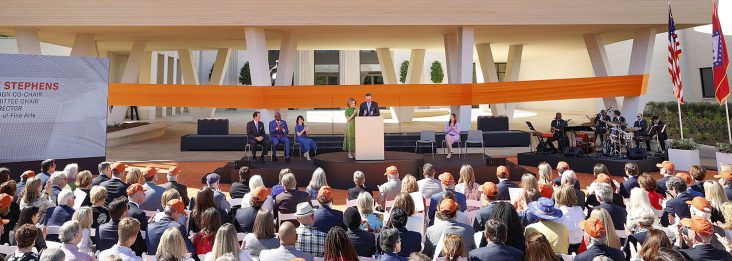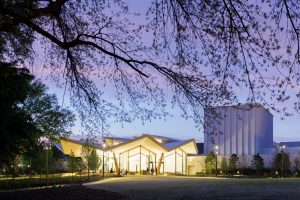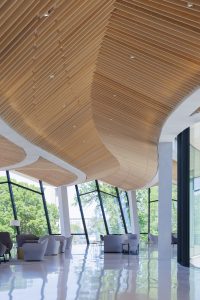A text message helped turn the Arkansas Museum of Fine Arts into a masterpiece
by April 24, 2023 9:21 am 2,614 views

The ribbon cutting for the Arkansas Museum of Fine Arts on Saturday, April 22, 2023. All photos courtesy of AMFA.
A text message received by Warren and Harriet Stephens during the week of Thanksgiving 2017 changed the scope of the major renovation of the Arkansas Museum of Fine Arts, formerly known as the Arkansas Arts Center.
Recruited by friends and museum supporters to steer the capital campaign to raise money for mechanical upgrades to the arts center building, the Stephens had asked leaders of the Windgate Foundation to raise their initial commitment from $15 million to $25 million in hopes of doing something more transformational on the project.
The day before Thanksgiving, Warren Stephens recalls getting a text from Robyn Horn, an Arkansas sculptor and wood artist who leads the Windgate Foundation.
“It started off, and my heart kind of sank. They said, ‘We’re not going to do $25 million… but we’re going to do $35 million.’ Harriet and I sat there for a few minutes dumbfounded. I’ve never had this happen to me in any capital fundraising campaign we’ve ever been a part of,” Warren Stephens said.
“Thanksgiving came early that year,” said Harriet. “It was the pivotal moment.”
That unexpected influx jumpstarted the Stephens to aspire to an even greater goal for the museum renovation and endowment. Over the course of the next several months and stretching into years, the goal lifted to $160 million. On Saturday (April 22) at the official ribbon-cutting ceremony to reopen the museum, a final capital campaign total of $170.8 million was announced.
There are a number of large donors to thank beyond Windgate. Terri and Chuck Erwin, Robyn and John Horn, Harriet and Warren Stephens, and the Winthrop Rockefeller Trust all made generous donations.
Little Rock voters deserve a tremendous amount of credit for the original investment in the reimagined arts complex, too. In 2016, voters approved a bond issue backed by a hotel room tax that resulted in a contribution of $31.245 million to the museum. There have been 34 gifts over $1 million and 113 gifts in the $100,000 to $1 million range. Museum supporters are thankful for small donors as well.

“The original goal was to double the city’s investment and have a $66 million budget,” Harriet Stephens said. “Mainly, the original design was going to back-house things, nothing really transformational about the museum itself, what you’d experience as a patron. We talked about it and we felt this was a moment in time. But we knew if we went further with it, we felt we were going to have to have a very significant gift.”
THE GALLERIES
During the grand re-opening this past weekend, art afficionados have been treated to the eight new galleries that feature world-class art from private collections and the museum’s permanent collections. The entire AMFA Foundation Collection totals 14,000 works.
The eight galleries include:
The Fine Arts Club New Media Gallery recognizes the Fine Arts Club (FAC), whose members first dreamed of bringing fine art to the state in 1914. The FAC founding members’ vision evolved into the Museum of Fine Arts in 1937, and then later into the Arkansas Arts Center in 1961, with the assistance of the Junior League of Little Rock and Governor and Mrs. Winthrop Rockefeller;
The Berta and John Baird Gallery honors Berta Baird, President of the Fine Arts Club, 1927 through 1936, and her husband, John Baird, for their leadership and perseverance to establish the Museum of Fine Arts, the first permanent facility for showcasing art in Arkansas in 1937, and their generosity in creating the museum’s original endowment;
The Governor Winthrop Rockefeller Gallery named in memory of the former Arkansas governor, for his generosity as a private citizen in championing the Arkansas Arts Center as a vital resource for the state and his unwavering support of the arts while in office, 1967 through 1971;
The Jeannette Edris Rockefeller Gallery named in memory of Mrs. Rockefeller who worked to bring the Arkansas Arts Center to life, for her service as President of the Board of Trustees, 1960 through 1968, and her support of the arts as First Lady of Arkansas, 1967 through 1971;
The Townsend Wolfe Gallery commemorates the museum’s longtime executive director and chief curator, from 1968 through 2002, for his extraordinary leadership and vision in making the museum a premier collector of works on paper;
The Jackson T. Stephens Gallery is named in memory of businessman and philanthropist Jack Stephens, whose generosity to the museum and the capital campaign of 1996 assisted the museum in better serving the people of Arkansas. His personal collection is on loan to the museum, where it has been accessible to the public for almost 20 years;
The Little Rock Gallery is dedicated to the citizens of Little Rock who supported the museum’s mission, most recently through the public-private partnership that powered the capital campaign, and;
The Harriet and Warren Stephens Family Gallery honors their children, their spouses, and their grandchildren, for inspiring them to co-chair the Reimagining of the Arkansas Museum of Fine Arts Capital Campaign for their generations of Arkansans and those to follow.
THE BUILDING IS A PIECE OF ART
The architecture of the new building is as much a piece of art as the collections it houses. Designed by world-renowned architect Jeanne Gang of Chicago-based Studio Gang, the 133,000 sq. ft. museum has a new north and south entrance, with the north entrance restoring an original art deco façade from the 1937 Museum of Fine Arts building that had been hidden for decades.

In addition to the galleries, there is much needed storage space to secure and preserve the art collection; new studio space for art classes; a renovated theater for children’s performances; an upscale restaurant and bar that opens up to the natural surroundings of MacArthur Park; an 11-acre landscaping makeover that draws the museum into the park; a research center and lecture hall; and stunning open spaces filled with light and seating for community gatherings or thoughtful musing on the art on display.
SCAPE, a landscape architecture and urban design practice based in New York, New Orleans, and San Francisco, oversaw the outdoor makeover that ties MacArthur Park and the museum together. There are over 250 different species of plants and trees that have been curated to redesign the outdoor space.
Arkansas contractors, Nabholz Construction and Doyne Construction, were heavily involved in the building process, aided by Pepper Construction, a national firm based out of Indiana. Little Rock-based Polk Stanley Wilcox was also involved in the architectural design.
“I feel enormous pride that we have, that the design team, which includes the contractors and the architects and the building committee, of course, have all delivered a building that I think is just extraordinary,” Harriet Stephens said, while noting this effort is not culminating in the grand re-opening. “The beginning is now.”
The Museum of Fine Arts will begin regular museum hours on May 2nd. Its regular hours will be Tuesday through Saturday from 10:00 a.m. – 8:00 p.m., and Sunday from 12:00 – 5:00 p.m.
You can watch an interview with Harriet and Warren Stephens in the video below.
